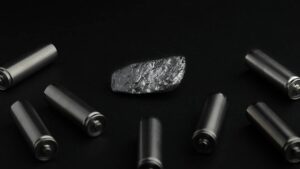As graphite approaches ‘tipping point’, buyers are eyeing Australia

Picture: Getty Images
The graphite market is heading quickly towards a supply deficit and this is likely to see more buyers look to Australia to help fill the gap.
David Christensen, the boss of graphite hopeful Renascor Resources (ASX:RNU), told Stockhead there was a “paradigm shift” happening where there won’t be enough graphite, either synthetic or natural, for the growing lithium-ion battery market.
“I think that the stories on needle coke and the increased pollution controls really speak more to some smaller issues on the supply side that are really being dictated by the demand,” he explained.
“And the demand is the growing use of graphite in lithium-ion batteries, whether it is synthetic or natural flake, and we’re reaching a tipping point.
“By 2021 it looks like the natural flake graphite market will be in slight undersupply, even with new projected supply from sources like Syrah, but by 2023 that becomes quite acute.”
Syrah Resources (ASX:SYR) began production from its Balama project in Mozambique in November 2017.
But the company has faced some hurdles in hitting its production goals, meaning it is not supplying what it expected to the market.
Syrah’s latest figures indicate Q2 will see lower production of 45,000 to 50,000 tonnes, revised down from between 50,000 and 55,000 tonnes previously.
That, coupled with India and China’s pollution crackdown efforts and China significantly ramping up its imports of flake graphite, is moving the graphite market rapidly towards undersupply.
At the same time, market forecaster Roskill sees demand for graphite in battery applications growing by 17-23 per cent each year between 2017 and 2027.
- Subscribe to our daily newsletter
- Join our small cap Facebook group
- Follow us on Facebook or Twitter
This more positive outlook has seen financiers eager to stump up cash and buyers seeking to shore up supply.
Renascor has secured in-principle support from Atradius, the official Dutch Export Credit Agency, for up to 60 per cent of the estimated $108m capital spend needed to build its Siviour operation in South Australia.
And securing financial backing is one of the biggest hurdles to building a graphite operation, according to Christensen.
“For companies like us this is a positive development because we’re trading on the market being aware that somewhere, whether it’s 18 months or 36 months, in the future there won’t be enough natural flake graphite,” he said.
“And in the cycle of developing a mine you need to have the time to get it forward plus you have to have the belief that there’s the future demand.”
At full production, Siviour is forecast to pump out 80,000 tonnes each year, which when it comes into operation in 2021 will be less than 10 per cent of global supply.
“When you see the supply side issues, not just on the demand side, I think then it really calls into question and makes people look more closely and it gives more belief to the strength of the need for more graphite developers,” Christensen said.
WA’s ‘Lithium Valley’ is getting a graphite production facility
Kibaran Resources (ASX:KNL), meanwhile, plans to build a battery graphite production facility utilising its EcoGraf processing tech in Kwinana – Western Australia’s new “Lithium Valley” located 30km south of Perth.
It would start out as a 5,000-tonne-per-annum operation at an initial cost of $US22.8m and expand to 20,000 tonnes per annum at a cost of $US49.2m.
Kibaran said graphite would be procured and processed at the Kwinana facility from a range of suppliers and would be exported to lithium-ion battery customers in Asia, Europe and the US.
The company already has financial support for its 60,000-tonne-per-annum Epanko graphite mine in Tanzania.
In early April, Germany’s KfW IPEX-Bank agreed to arrange a senior debt funding facility for the project.
Because of its low sovereign risk, Australia is a pretty attractive option for Western or Eastern buyers.
“The large battery makers are the Japanese, the Koreans and the Chinese, and currently all of the natural flake graphite that goes into lithium-ion batteries comes from China,” Christenson said.
“We think we provide a great alternative to that, in particular for the Koreans and the Japanese who are dependent on their chief competitor in the battery space for one of their key raw materials – graphite.
“In terms of trying to sell material into the rest of the market, we think we may be an attractive potential provider of graphite for the west as well.”
Renascor has already secured one memorandum of understanding with a Chinese group, but with financial support from the Dutch believes it will be able to secure more favourable offtake deals with Europe as well as Asia.
UNLOCK INSIGHTS
Discover the untold stories of emerging ASX stocks.
Daily news and expert analysis, it's free to subscribe.
By proceeding, you confirm you understand that we handle personal information in accordance with our Privacy Policy.








